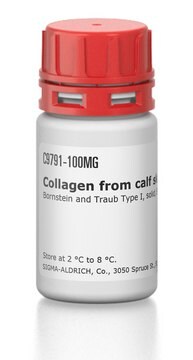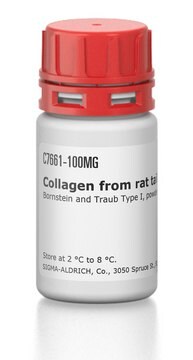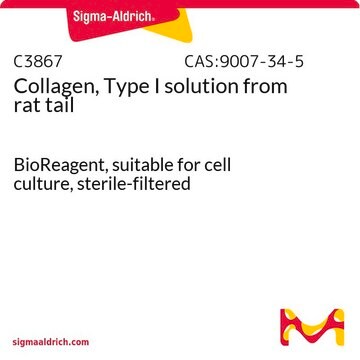추천 제품
생물학적 소스
bovine (calf) skin
양식
solid
기술
cell culture | mammalian: suitable
solubility
aqueous acid: soluble
적합성
suitable for substrate for collagenase
UniProt 수납 번호
저장 온도
2-8°C
유전자 정보
bovine ... COL1A1(282187)
유사한 제품을 찾으십니까? 방문 제품 비교 안내
애플리케이션
This product is intended to produce thin layer coatings on tissue culture plates to facilitate attachment of anchorage-dependent cells, recommended for use at 6-10 μg/cm2. It is NOT intended for production of 3-D gels. Type I collagen is often used in cell culture as an attachment substratum with myoblasts, spinal ganglia, hepatocytes, embryonic lung, heart explants, fibroblasts, endothelial cells, and islet cells have all been cultured successfully on films or gels of type I collagen. Collagen type I may also be used in research of Idiopathic pulmonary fibrosis (IPF), studies on the effect of ER stress IPF on lung fibroblasts. Collagen in acidic solution can produce three dimensional scaffolding with use in bioengineering and cell culture applications.
생화학적/생리학적 작용
Type I collagen is a component of skin, bone, tendon, and other fibrous connective tissues.
성분
All collagen molecules are composed of three polypeptide chains arranged in a triple helical conformation, with a primary structure that is mostly a repeating motif with glycine in every third position and proline or 4-hydroxyproline frequently preceding the glycine residue. Type I collagen differs from other collagens by its low lysine hydroxylation and low carbohydrate composition.
제조 메모
Prepared by a modification of the method of Gallop, P.M., and Seifter, S., Meth. Enzymol., VI, 635 (1963).
기타 정보
Collagen is classified into a number of structurally and genetically distinct types. We use the nomenclature proposed by Bornstein and Traub. Do not confuse Sigma type designations with recognized collagen classification types.
Storage Class Code
11 - Combustible Solids
WGK
WGK 1
Flash Point (°F)
Not applicable
Flash Point (°C)
Not applicable
개인 보호 장비
Eyeshields, Gloves, type N95 (US)
In vitro and in vivo models for evaluation of GDEPT: quantifying bystander killing in cell cultures and tumors.
William R Wilson et al.
Methods in molecular medicine, 90, 403-431 (2003-12-06)
Qiyin Fang et al.
The Review of scientific instruments, 75(1), 151-162 (2004-01-01)
We report the design and development of a compact optical fiber-based apparatus for in situ time-resolved laser-induced fluorescence spectroscopy (tr-LIFS) of biological systems. The apparatus is modular, optically robust, and compatible with the clinical environment. It incorporates a dual output
S Teixeira et al.
Journal of biomedical materials research. Part A, 95(1), 1-8 (2010-08-27)
This study concerns the preparation and in vitro characterization of functionalized hydroxyapatite (HA) porous scaffolds, which are intended to be used as drug-delivery systems and bone-regeneration matrices. Hydroxyapatite scaffolds were prepared using the polymer replication method, and, after being submitted
Zhongcheng Gong et al.
Biomedical materials (Bristol, England), 5(5), 055005-055005 (2010-09-10)
The objective was to investigate synovium-derived stromal cells (SDSCs) coupled with chitosan/collagen type I (CS/COL-I) scaffolds for cartilage engineering. CS/COL-I scaffolds were fabricated through freeze-drying and cross-linked by 1-ethyl-3-(3-dimethylaminopropyl)carbodiimide. SDSCs were isolated from synovium and cultured onto CS/COL-I scaffolds, constructs
Reactive oxygen species are required for maintenance and differentiation of primary lung fibroblasts in idiopathic pulmonary fibrosis.
Bocchino M., et al.
PLoS ONE, 5 (2010)
자사의 과학자팀은 생명 과학, 재료 과학, 화학 합성, 크로마토그래피, 분석 및 기타 많은 영역을 포함한 모든 과학 분야에 경험이 있습니다..
고객지원팀으로 연락바랍니다.








